Types of terraces and their features. Design and order of work. Vertical layout, slope reinforcement and decoration. Terracing of a site is a set of measures aimed at creating horizontal sites in the presence of uneven terrain with a predominance of hills and slopes. They prevent the topsoil from being washed away and are used for planting ornamental plants. About how to make terracing of a site, our today's material.
Types and features of terraces
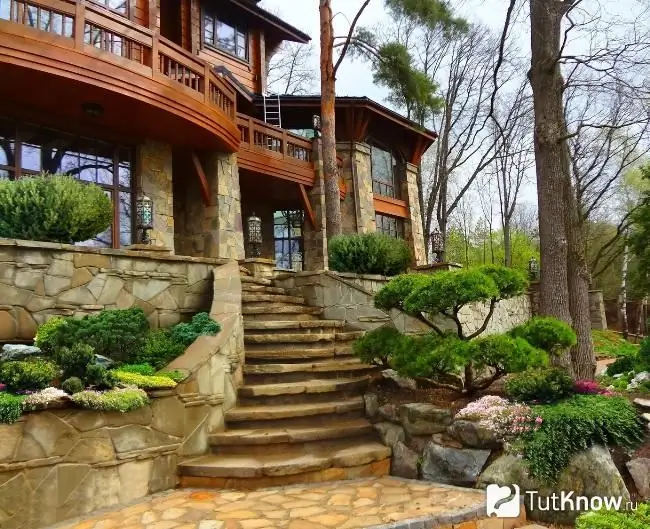
The functions and design features of terraces that are created on slopes depend on the slope of the soil surface and the thickness of its fertile layer.
There are four main types of terraces:
- Ridge … They are created on an area with a slope of no more than 0, 12. Their construction involves the construction of earthen embankments across the slope, with a height of up to 40 cm. Such terraces are used for planting grapes, fruit plants and do not exceed 50 cm in width.
- Stepped … They are the most reliable, attractive in appearance and therefore the most popular. Such terraces are arranged on soil slopes up to 0.25, have a width of 3 m and are reinforced with stone masonry, which makes them strong and stable. Stepped terraces are suitable for planting fruit and forest crops, grapes and vegetables.
- Trench … Such terracing is carried out when the slope of the terrain is up to 0, 18 and more. The fertile soil layer in this case is very thin. In the process of work, the subsoil layer is removed from the trenches, then they are filled with soil and the shafts are poured. Trench terraces are good for growing citrus or tea.
- Terraces-ditches … They are arranged on the slopes of the site up to 1 with a thin fertile soil layer. In the process of work, soil is taken from the ditches to collect or drain water and fill the shafts. Such terracing makes it possible to plant fruit plants.
For independent terracing of a plot with a slope and turning it into a magical land, you need to consistently perform a number of activities, while showing patience, hard work and accuracy:
- Carry out a markup of the area to be processed, it should be fenced off with a cord stretched over hammered stakes;
- Cut off the soil in the upper part of the slope and pour it into the lower part, thereby reducing the slope of the site;
- Make a drainage system, and, if necessary, lay water supply pipes;
- Mount retaining walls and make steps;
- Construct waterfalls, mixborders or alpine slides;
- Perform wall cladding;
- Pave the paths of the site with stones or tile;
- Prepare terraces for planting;
- Install architectural elements;
- Fill artificial reservoirs.
Advantages of landscape terracing
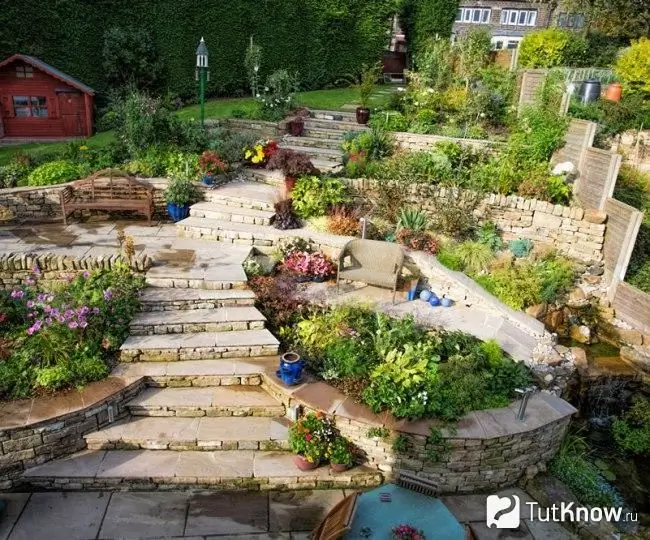
The result of correct terracing of a land plot is not only a neat surface of its relief, but also a decorative arrangement of the territory.
The advantages of a vertical and horizontal layout of a personal plot include:
- Prevention of soil erosion;
- Possibility of a simple drainage device;
- Convenient division of the territory into economic zones;
- Huge design possibilities;
- The uniqueness of the work result;
- Long service life of terraces;
- The ability to transform the disadvantages of natural relief into the advantages of an artificial landscape.
The terracing areas with steps look flawless. They can be placed on the slopes or they can be used to form approaches to artificial or natural reservoirs, vineyards, etc. Ornamental plants can be planted along the edges of such sites. In any case, such a design of the territory leads only to a positive result.
How to terracing a plot with a slope
The construction of terraces involves excavation of soil from the upper part of the slope and backfilling into its lower part until a flat plane is formed.
Preparatory work before terracing the site
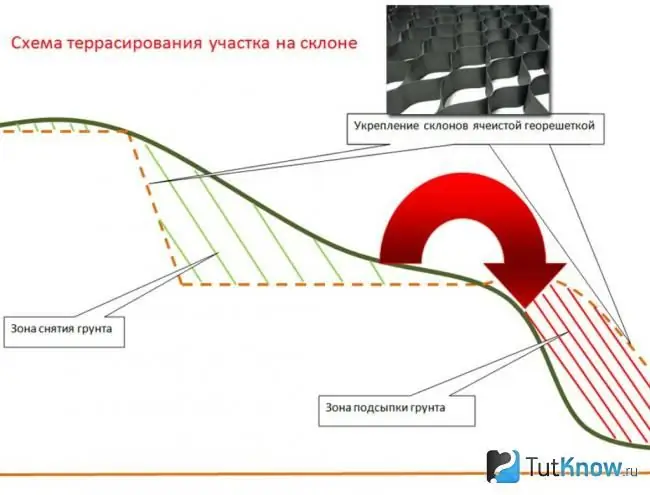
Before terracing a summer cottage, it is important to take into account several nuances that affect the design of the sites:
- The level of soil water occurrence in the "wettest" seasons of the year - in autumn and spring;
- The size of the slope of the site;
- The composition of the soil and its features;
- Differences in the height of the relief, as well as changes in its slopes in the horizontal and vertical directions.
Having determined these parameters, you can calculate the number of sites, their sizes, method of operation and the height of their slopes. In addition, a preliminary study of the land plot will help to resolve the issue of the need for the construction of drainage or drainage communications. After analyzing the soil and local relief, it will be possible to determine the functionality of the site, create the correct composition of sites and steps, select plants for decorating the terraces and, finally, draw up a work plan.
Before terracing, the site should be divided into fragments that meet all the rules for sizing. When planning complex objects, for example, a pond, flower garden or alpine slides, you will need to draw up a breakdown plan.
Creating contour lines
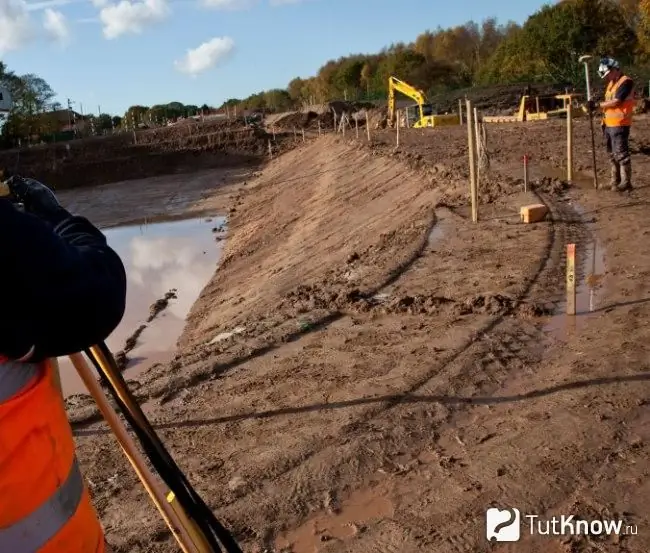
In order for the platforms to be within the horizontal, you need to create conditional lines for them using cords and pegs. First, the peg must be driven into the slope, and then the site is divided into parts corresponding to the one and a half width of the planned terrace.
The remaining points for placing the pegs must be determined using a level. After the formation of the first contour, you can do the rest. Then you should carry out the filling of soil, creating sites according to the project. They should have a slight slope to accommodate rainwater drainage.
Strengthening slopes
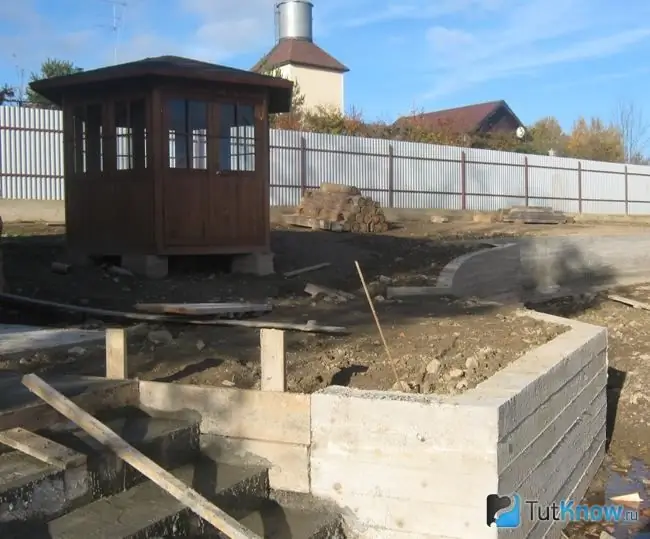
There are three main ways of such strengthening to protect terraces from soil leaching:
- Planting ornamental shrubs or trees around the edges of the pads … This is the easiest method to prevent soil erosion from terraces. Plants to be used for planting must be able to create a dense network with their root system, located in the upper layers of the soil. Usually it is lilac, juniper or hawthorn. This method is used to strengthen inclined slopes.
- Installation of a grid or geogrid … It is used for the same purpose and can be combined with planting. At the same time, the branched roots of the shrubs, intertwining with the mesh deployed on the slope, form a very strong reinforcing structure.
- Laying concrete slabs … They are also used to reinforce inclined slopes and need to be firmly anchored to the ground to prevent slipping during heavy rainfall. In addition to concrete slabs, paving slabs can be used.
Strengthening vertical slopes
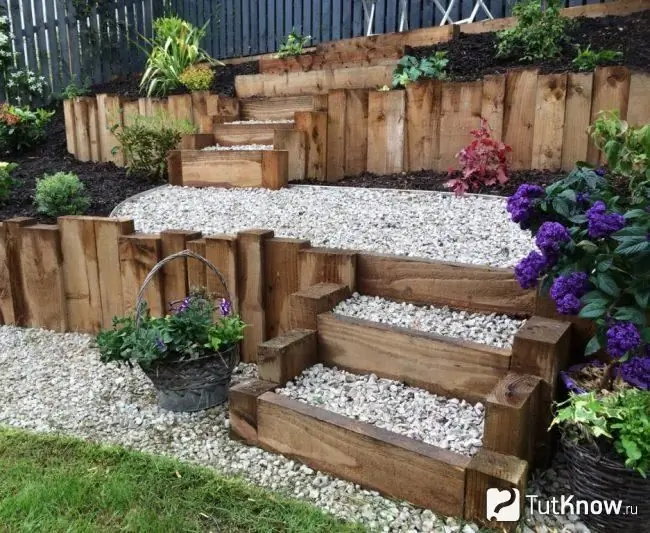
Retaining walls are the most practical and most common method of reinforcing vertical slopes when terracing a site. Such structures can be light and capital. Lightweight structures have a height of up to 1 m; a foundation is not required for their construction. For solid retaining walls up to 3 m high, cushions of gravel or concrete blocks buried in the ground are required. Particular attention should be paid to the laying of blocks - they must support a large mass of soil. The thickness of such a foundation should be 60-70 cm, and the width should be at least 25 cm.
For the construction of retaining walls, you can use logs, concrete blocks, brick and stone, as well as monolithic concrete. Most of these materials are suitable for natural stone - limestone, quarrystone, etc. Facing or ordinary clay brick looks good on the wall. However, it is inferior in weather resistance to natural stone. If the terrace has a slight slope, retaining walls for it can be constructed from short logs with dense wood, such as larch.
In terms of decoration, retaining walls offer great opportunities for artistic creativity. With their help, you can create beautiful compositions in different styles, ranging from medieval to modern. Such structures can be decorated with lanterns, wooden and stone stairs and other attributes of garden architecture.
Among the advantages of retaining walls are their solid service life and easy maintenance. Despite this, it is important to know that such a structure is a complex engineering structure. If it is not built correctly, it can collapse and become dangerous for the owners and guests of the house.
Therefore, when erecting it, one should be guided by the following rules:
- The recessed foundation must be solid.
- The ratio of the height of the wall to its width should be 3: 1.
- A water conduit must be made in front of the top of the retaining wall in order to prevent its base from being washed away by irrigation or rainwater.
- To increase stability, the support wall should be erected with a slight slope towards the top of the terrace.
- The construction of the structure must be started from the bottom of the site.
Construction of stairs

When terracing a site on a slope, all sites must be connected by stairs. Their appearance and location should be considered at the design stage. Moreover, it is necessary to approach the issue of their installation from a practical standpoint.
If the stairs are to lead to those objects that are used all year round, it is recommended to make them comfortable for walking, clearing ice and snow. The steps of such stairs should not be slippery. Railings should be installed on steep stairs and supplied with lighting.
Standard garden stairs are usually flat, the width of their steps is about 30 cm, and the height is no more than 10 cm. If the structure does not bear a heavy load, it can be made of natural stone or wood.
Terrace decoration
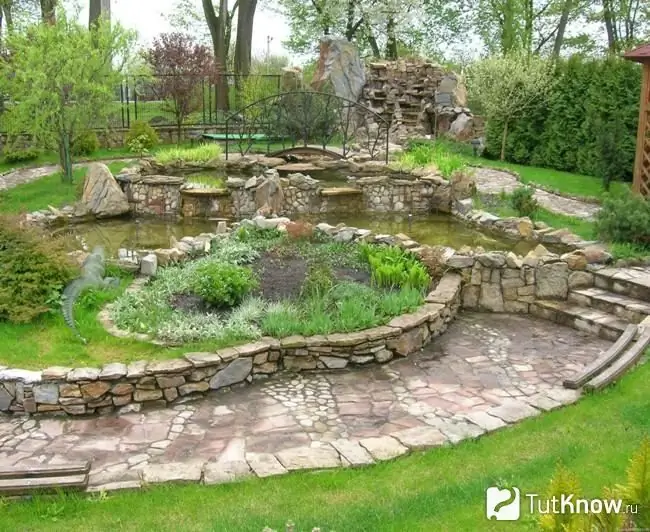
It can be done when the terraces are completely ready. When decorating, it is difficult to do without beautiful flowers. Thanks to them, you can create unique compositions from various varieties of these plants. You can safely plant fruit trees on the slopes. Herbaceous plants - nasturtiums or petunias - can give the terrace an excellent view. You can use juniper or Japanese spirea bushes in the decor.
In addition, the terraces are convenient for organizing gutters, in which there can be mini-waterfalls imitating forest streams, or a cascade consisting of several small reservoirs located on adjacent terraces. It looks especially beautiful if a large area has been allocated for terracing.
Making out the retaining walls, it is useful to plant ivy near their head. This evergreen plant will transform any structure into a green carpet or chic hedge over time.
When planning the device of a terrace for planting any plants, it should be borne in mind that just one degree of the slope of the site is enough to shift it by climatic factors by 8 km in the direction of the slope. In practice, it looks like this: if the plot has a 20 slope towards the north, this means that it is recommended to plant plants on the terrace, such as in an area located about 180 km north of your garden.
How to terracing a site - watch the video:

Based on the above, we can conclude that all terracing options make it possible to implement many design solutions, giving the territory on the slope individuality and a beautiful look. Compliance with the requirements when performing these difficult works will allow you to do terracing of the site with your own hands, completely eliminating the need for financial costs to attract hired workers.






